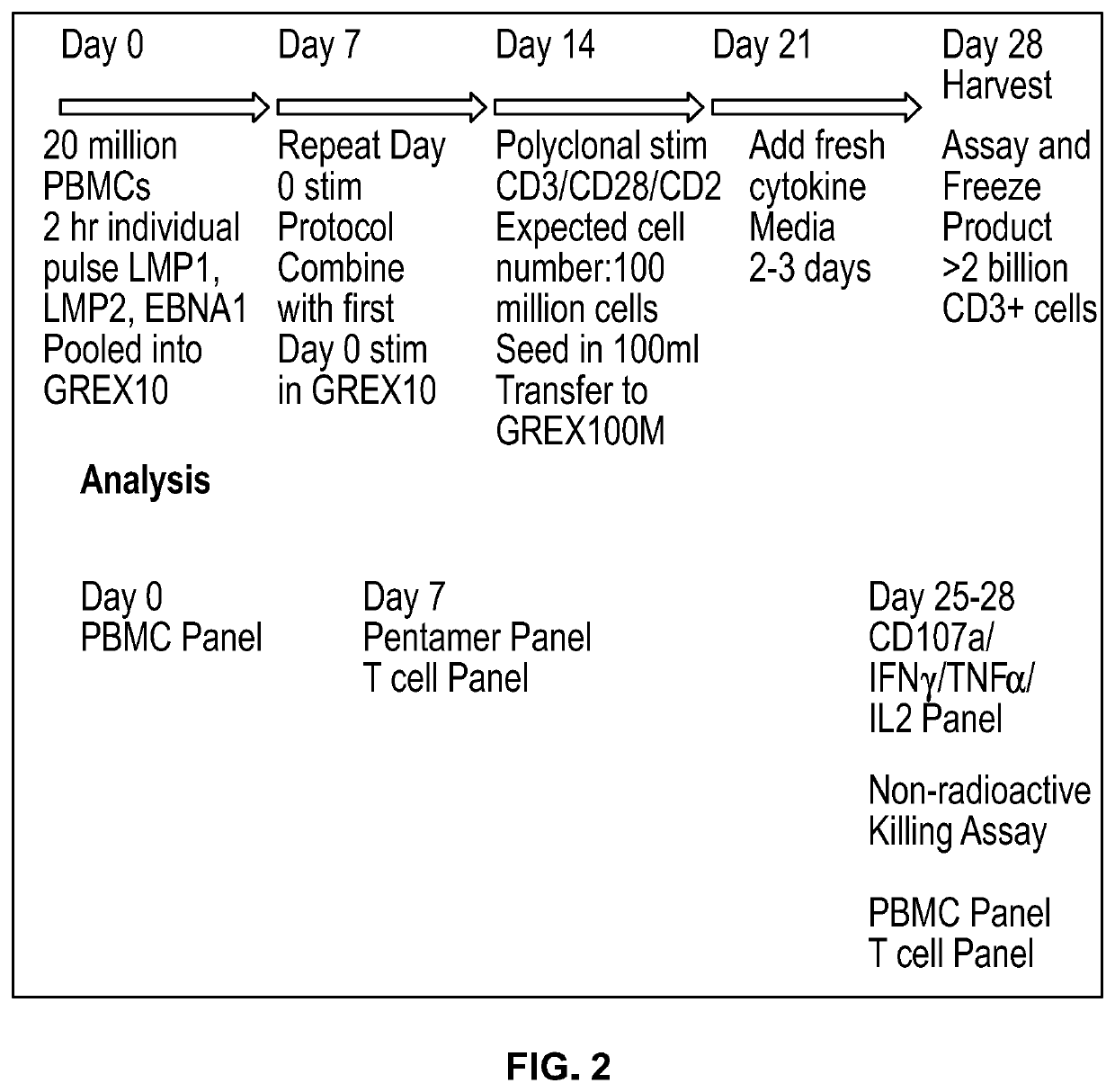T cell compositions for immunotherapy
a technology of immunotherapy and composition, applied in the field of immunotherapy, can solve the problems of ineffective promotion of tumor regression and inconsistencies in outcome, and achieve the effects of good viability, recovery and morphology
- Summary
- Abstract
- Description
- Claims
- Application Information
AI Technical Summary
Benefits of technology
Problems solved by technology
Method used
Image
Examples
example 1
pansion Platform
[0204]Experimental Procedures
[0205]Antigen selection: PepMixes are a pool of peptides (also referred to herein as “polypeptides”) derived from a peptide scan of the target antigen of interest (each polypeptide is 15 amino acids with 11 amino acid overlap) that are capable of stimulating CD4+ and CD8+ T cells without the requirement of knowing HLA restriction. PepMixes for LMP1, LMP2, EBNA1, CMV, NYESO-1, and Survivin were purchased from JPT Peptide Technologies, Berlin. Each vial of pepmix consisted of approximately 15 nmol or 25 micrograms of each peptide at 70% purity. Individual LMP2 peptides and custom epitope mapping matrix pools were also purchased from JPT Peptide Technologies, Berlin.
[0206]Listed are the Pepmix compositions and source of the protein sequence of the antigens used to expand T cells from normal donor and cancer patients:[0207]PepMix EBV(LMP1): Pool of 94 peptides derived from Latent membrane protein 1, Swiss-Prot ID: P03230 of Epstein-Barr virus...
example 2
lture Conditions
[0219]Experimental Procedures
[0220]Cytokines: GMP grade cytokines for use in T cell expansion were purchased from Miltenyi Biotech and stock solutions were prepared at 25 ug / ml in sterile dH20 and stored at −70 degC. Cytokines were used at Human IL-2 100 IU / ml final concentration and 10 ng / ml for IL-7 and IL-15.
[0221]Frozen PBMCs were stimulated with 1 ug / ml Pepmix during extended culture or at 3 ug / ml during 2 h pulse followed by pooling. DMSO concentration with 1 ug / ml Pepmix culture was 0.4% and no cellular toxicity was observed. PBMCs pulsed with 3 ug / ml Pepmix had a 1.2% DMSO concentration during incubation which was washed away prior to extended cell culture. Flow cytometry was performed on aliquots from Days 0, 7, 14, 21 and or 28 of T cell expansion. Frozen Day 0 PBMC samples were stained for antibodies to characterize starting cell populations: live / dead, anti-CD3 for total T cells, CD8 and CD4 subsets, CD14 / CD4 for monocytes, CD56 for NK cells, and CD19 for...
example 3
Small Scale Expansion of Non-Hodgkins Lymphoma Clinical Samples
[0226]Experimental Procedures:
[0227]Flow cytometry: 200,000 cells were stained with antibody panels following standard flow cytometry procedures.
[0228]PBMC panel: live / dead, CD3, CD4, CD8, CD14, CD56, CD19.
[0229]Intracellular cytokine expression: live / dead, CD3, CD4, CD8, CD45RO, CD45RA, CD107a, TNFa, IFNg, IL-2.
[0230]T cell activation panel: Antigen specific pentamer, live / dead stain, CD3, CD4, CD8, CD56, CD45RA, CD45RO, CD25, CD62L, CD137, CD197, and CD279.
[0231]T cell Memory panel: live / dead, CD3, CD4, CD8, CD45RO, CD45RA, CD197, CD28, CD122, CD127, CD183, CD95, and CD62L.
[0232]Small scale expansion protocol: On Day 0, 2 vials of NHL frozen PBMCs (HemaCare, Donor NHL 14103815) were thawed using CTL anti-aggregate solution according to manufacturer's protocol. Cells were washed and resuspended in CellGro DC Media (CellGenix)+10% Human AB Serum (Corning)+1% GlutaMax (Gibco), and an aliquot was removed for counting and F...
PUM
| Property | Measurement | Unit |
|---|---|---|
| humidity | aaaaa | aaaaa |
| concentration | aaaaa | aaaaa |
| concentration | aaaaa | aaaaa |
Abstract
Description
Claims
Application Information
 Login to View More
Login to View More - R&D
- Intellectual Property
- Life Sciences
- Materials
- Tech Scout
- Unparalleled Data Quality
- Higher Quality Content
- 60% Fewer Hallucinations
Browse by: Latest US Patents, China's latest patents, Technical Efficacy Thesaurus, Application Domain, Technology Topic, Popular Technical Reports.
© 2025 PatSnap. All rights reserved.Legal|Privacy policy|Modern Slavery Act Transparency Statement|Sitemap|About US| Contact US: help@patsnap.com



